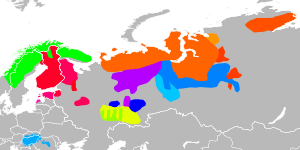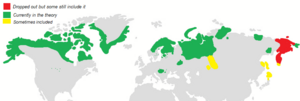Uralic languages facts for kids
Quick facts for kids Uralic |
|
|---|---|
| Geographic distribution: |
Eastern and Northern Europe, North Asia, Siberia |
| Linguistic classification: | One of the world's major language families (possibly Uralo-Siberian family) |
| Proto-language: | Proto-Uralic |
| Subdivisions: |
Khanty
Mansi
Mari
Mordvinic
Permic
Samoyedic
|
| ISO 639-5: | urj |
 |
|
The Uralic languages are a group of languages that are related to each other. They were first spoken in Eastern Europe and Asia. Many experts believe they started in eastern Siberia, near Lake Baikal.
Today, there are two main branches of Uralic languages: the Samoyedic languages and the Finno-Ugric languages.
Contents
Where Uralic Languages Began
The very first Uralic languages and the people who spoke them likely came from eastern Siberia or Northeast Asia. These early people were similar to other groups in Siberia and East Asia, including the Inuit people.
About 3,000 years ago, these groups started moving. They traveled from central Siberia towards the Baltic region in northeastern Europe. As they moved, they met and mixed with many local tribes. Studies of genes and ancient people show that the early Uralic people looked like various groups from Siberia and East Asia.
How Uralic Languages Are Connected to Others
Some language experts and scientists think that Uralic languages are related to other languages in Siberia. They might even be connected to some languages spoken by Native Americans in the north.
This bigger group of languages is sometimes called Uralo-Siberian. It could include Uralic languages, along with Yukaghir, Eskimo–Aleut (which includes Inuit languages), and possibly Nivkh and Chukotko-Kamchatkan languages.
List of Uralic Languages
Here are some of the languages that belong to the Uralic family:
- Finno-Ugric languages
- Samoyedic languages
- Nenets
Images for kids
-
This 1549 map by Sigismund von Herberstein shows "Yugra from where the Hungarians originated" east of the Ob River. This shows how people long thought Hungarians came from the Uralic/Siberian area. The Ural Mountains are called Montes dicti Cingulus Terræ ("The mountains called the Girdle of the Earth").
See also
 In Spanish: Lenguas urálicas para niños
In Spanish: Lenguas urálicas para niños




